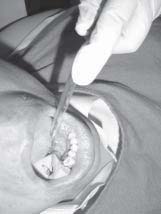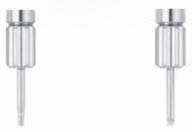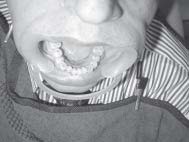Outline
Several studies have evaluated the advantages and disadvantages of screw-retained and cementretained implant-supported restorations.1,2,3&4 The use of definitive or provisional cements for the cementation of implant-supported restorations is an acceptable alternative to screw-retained implant-supported crowns.5 Cement retained implant prosthesis offer several advantages over screw retained implant prosthesis. These include more passive castings,
improved direction of loads, easier manipulation in posterior regions especially in patients with limited mouth opening & enhanced esthetics.6 The statement that screw retained prosthesis is retrievable and cement retained is not, is far from
true. The access hole for prosthetic screw in screw retained prosthesis is often obturated with composite. This requires the clinician to remove the composite obturation before gaining access to prosthetic screw. All this involves considerable
chiar side time. On the other hand, a cement retained implant prosthesis, even when luted with definitive cement is still retrievable because unlike tooth, the cements do not chemically adhere to the underlying metallic abutments here. Also the metallic abutment is totally free of undercuts which is a possibility in prepared tooth especially if it was previously restored. 6
But the real challenge is removing a cement retained prosthesis when the underlying abutment screw has loosened. The possibility of using a regular crown remover is ruled out here because rather than cement abutment interface, the stress here would be transmitted to the loosened abutment screw. This can result in a more serious complication of abutment screw fracture. The other standard procedure of removing prosthetic crowns from natural teeth involves sectioning the prosthetic crown mid facially to try breaking the cement seal and then pulling the sectioned crown
out with some instrument like scaler. This too has a limited value in case of cement retained implant prosthesis since the metal of the restoration is much thicker in this case. Secondly this involves the risk of damaging the abutment screw head making it practically non retrievable. Few techniques have been described in literature for retrieving cement retained prosthesis including the one involving, putting a stain on ceramic restoration occlusally to indicate the location of abutment screw.7 This article describes a simple, innovative and predictable procedure of removing a cement retained prosthesis in the event of abutment screw loosening.
Clinical case
A male patient aged 38 years reported to Dept. of Prosthodontics, Himachal Dental College. The patient had undergone implant surgery in 45 region and also received a prosthesis for the same at a private clinic. But subsequent to prosthesis placement, the patient noticed some movement in the prosthesis within 2 days. The patient as well
as the clinician perceived this as an implant failure and the patient was referred to the hospital to do the needful.
The X rays of the patient did not reveal any obvious bone loss to call it an implant failure. There was no abcess formation as well. On evaluation it was found that patient had no pain on movement of prosthesis. Also there was limited movement of prosthesis in the vertical direction. All this pointed towards the possibility of abutment
screw loosening. Further examination revealed that there were definite occlusal prematurities on implant prosthesis. So it was decided to remove & replace the prosthesis. The technique followed is elaborated below:
Technique:
1. Used sharp carbide to cut through ceramic & metal part of crown on 45 occlusally. As soon as the metal coping is perforated the sealer over abutment screw head was seen. (fig.1, fig.2)
2. On visualizing the sealer, the drilling procedure was stopped to prevent any harm to abutment screw.
 | Fig 1
 |
 | Fig 2
 |
3. The other thing, clinician has to be worried about is fracture or damage to the abutment screw, because of the movement of abutment during drilling. It has been suggested, in literature, to hold crown tightly with hemostat
to minimise movement. But in reality it can be tricky to do the same. We have instead devised a different method to hold the restoration with abutment in place. A putty index(poly vinyl siloxane addition silicone) was created over the faulty implant restoration ant the adjoining teeth. Then the index was sectioned over the implant restoration making
way for the air rotar carbide bur. This index when held in mouth stabalises the implant restoration in place. Additionally it also aids in tongue and cheek retraction during the procedure.(fig. 1, fig.2)
4. After removing the sealer the abutment screw was removed with hand driver (fig.3) and cemented crown was removed along with the abutment.
5. A fresh abutment was used and a new metal ceramic crown was fabricated with correct occlusion.
 | Fig 3
 |
6. Abutment screw was torque tightened with torque wrench (fig.4) to 22.5 N cm. As recommended in literature we waited for 10 min before retightening the screw again to the same value. As expected the screw does loosen a bit after the first tightening.
 | Fig 4
 |
The new restoration was then cemented in place in 45 region after checking occlusal accuracy.(fig.5, fig.6)
 | Fig 5
 |
 | Fig 6
 |
Discussion
The patient was told by the clinician that the occlusal discrepancy would settle down within a week or so with the opposing dentition wearing off a bit in natural course. This was probably the point where the clinician went wrong. Scientific literature shows that there are two prime causes of abutment screw loosening:
1. Occlusal over load: Screw loosening has been reported to occur with a three-year frequency of from 3 percent to 38 percent in screwretained posterior restorations. Screw loosening is more likely in single-unit restorations, and can often be related to excessive loading. Screw loosening occurs when compressive occlusal forces are higher than the tension in the screw-implant assembly that holds the components together (the clamping force).
2. Insufficient torque tightening: Most standard implant kits have a hand driver to tighten the abutment screw. Or they make use of a non calibrated ratchet to tighten the abutment screw. But almost all standard companies sell a prosthetic implant kit separately which includes a torque wrench. Though expensive, torque wrench is considered indispensable by
most dentists who restore implants. Companies recommend that abutment screw be tightened to a particular value which usually ranges between 20 to 40 N cm depending upon the system. Such torque values are not predictably achievable with hand drivers or non calibrated ratchets. Torque tightening the abutment screw creates a pre load in the same, which can predictably hold together the abutment and implant assembly.
Variation to the above technique involves simply retightening the abutment screw after gaining access to the same and filling the access hole with composite. But literature suggests that if a screw is tightened once to the recommended
value, it streches a little thus creating a pre load.The same pre load is not achievable again. Also the screw might have undergone some deformation due to prosthesis movement after screw loosening. Also the possibility of patient accepting a repaired crown is remote since implant patient is usually a highly conscious and demanding patient for right reasons. To make use of the same abutment, the abutment with the cemented crown can be kept in porcelain furnace at standby temperature (normally 400 C degree or less). Close it without running a baking program for five to ten minutes. Open the furnace, hold the Crown with a large hemostat (screw facing down), hit the hemostat with an object like another hemostat and the butment might fall off. Be cautious because they are hot! But we did not follow the procedure because
of reluctance of the company to supply us abutment screw separately ( without abutment) Summary: As clear from the discussion the clinician has to be very thorough with the occlusal concepts in implant dentistry. Also, the article highlights the need for using accessory prosthetic torque wrench to tighten the abutment screw. A simple procedure for replacing the cement retained prosthesis has been outlined in case the screw loosening complication occurs.
References:
1. Goodacre CJ, Kan JY, Rungcharassaeng K. Clinical complications of osseointegrated implants. J Prosthet Dent
1999;81:537-52
2. Chee W, Felton DA, Johnson PF, Sullivan DY. Cemented versus screw retained implant prostheses: which is better? Int J Oral Maxillofac Implants 1999;14:137-41.
3. Hebel KS, Gajjar RC. Cement-retained versus screw-retained implant restorations: achieving optimal occlusion and esthetics in implant dentistry. J Prosthet Dent 1997;77:28-35.
4. Michalakis KX, Hirayama H, Garefis PD. Cement-retained versus screwretained implant restorations: a critical review.
Int J Oral Maxillofac Implants 2003;18:719-28.
5. Breeding LC, Dixon DL, Bogacki MT, Tietge JD. Use of luting agents with an implant system: part I. J Prosthet Dent
1992;68:737-41.
6. Misch CE. Principles of cement retained fixed implant prosthesis. In: Misch CE. Implant Dentistry. 2nd ed. Mosby:
Elsevier; 1999. p. 550-4.
7. Schwedhelm, Ariel J. Raigrodski. A technique for locating implant abutment screws of posterior cement-retained metalceramic restorations with ceramic occlusal surfaces J Prosthet Dent 2006;95:165-167. |